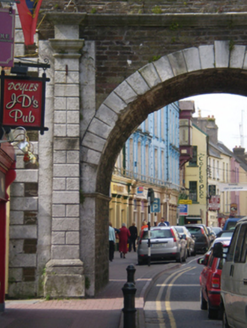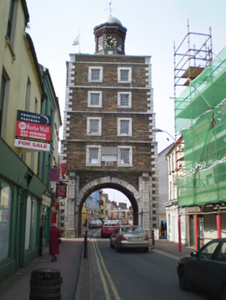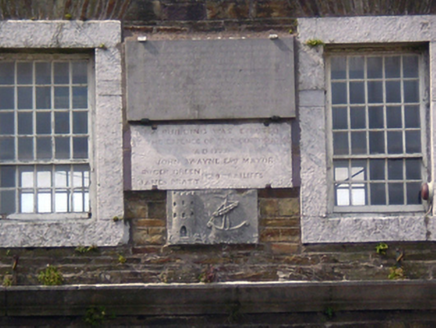Survey Data
Reg No
20823120
Rating
National
Categories of Special Interest
Archaeological, Architectural, Artistic, Historical, Scientific, Social, Technical
Original Use
Gates/railings/walls
Historical Use
Prison/jail
Date
1775 - 1780
Coordinates
210582, 77798
Date Recorded
01/04/2007
Date Updated
--/--/--
Description
Freestanding two-bay five-storey gatehouse, built 1777, having round-headed arch to ground floor with road running through and with octagonal cupola addition to roof. Formerly in use as gaol. Flat roof with sandstone parapet having dressed limestone coping. Metal dome to cupola having timber cornice and metal weather vane. Cut sandstone walls with dressed limestone quoins and string courses dividing stories. Dressed limestone pilaster style buttresses with carved capitals and plinths to ground floor. Carved rusticated limestone plaques with incised lettering and carved limestone plaque with image of castle and boat in relief. Metal clock faces to cupola. Square-headed openings with dressed limestone surrounds and sills and multiple pane timber sliding sash windows. Round-headed arches with rusticated dressed limestone voussoirs. Square-headed opening to south-west elevation with cut sandstone voussoirs and timber battened door, approached by flight of cut limestone and sandstone steps.
Appraisal
Standing on the site of the medieval Iron or South Gate, this imposing and landmark structure is a notable and unusual feature within the town of Youghal. It was designed by William Meade and served as the town gaol until 1837. In 1798 the patriots, Charles O’Brien and Charles Gallagher were hanged from its windows. The date plaques add further historical and social context and indicate that the structure was erected “at the expense of the corporation” at a time when John Wayne Esq. was mayor and Roger Greene and James Pratt were town bailiffs. The imposing height and austere style of the building implicate its former use and enhance its unique setting. The vertical thrust of the elevation is offset by the stringcourses, which together with the quoins, voussoirs and buttresses show evidence of fine stone crafting.





